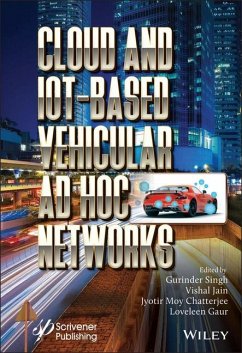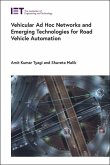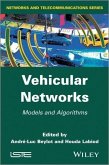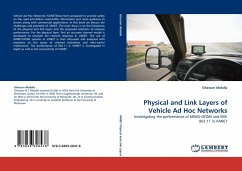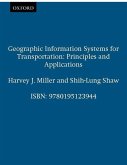Cloud and Iot-Based Vehicular AD Hoc Networks
Herausgeber: Singh, Gurinder; Gaur, Loveleen; Chatterjee, Jyotir Moy; Jain, Vishal
Cloud and Iot-Based Vehicular AD Hoc Networks
Herausgeber: Singh, Gurinder; Gaur, Loveleen; Chatterjee, Jyotir Moy; Jain, Vishal
- Gebundenes Buch
Andere Kunden interessierten sich auch für
![Vehicular Ad Hoc Networks and Emerging Technologies for Road Vehicle Automation Vehicular Ad Hoc Networks and Emerging Technologies for Road Vehicle Automation]() Amit Kumar TyagiVehicular Ad Hoc Networks and Emerging Technologies for Road Vehicle Automation176,99 €
Amit Kumar TyagiVehicular Ad Hoc Networks and Emerging Technologies for Road Vehicle Automation176,99 €![Vehicular Networks Vehicular Networks]() Vehicular Networks214,99 €
Vehicular Networks214,99 €![Physical and Link Layers of Vehicle Ad Hoc Networks Physical and Link Layers of Vehicle Ad Hoc Networks]() Ghassan AbdallaPhysical and Link Layers of Vehicle Ad Hoc Networks56,99 €
Ghassan AbdallaPhysical and Link Layers of Vehicle Ad Hoc Networks56,99 €![Hydrogen Fuel Cells for Road Vehicles Hydrogen Fuel Cells for Road Vehicles]() Pasquale CorboHydrogen Fuel Cells for Road Vehicles121,99 €
Pasquale CorboHydrogen Fuel Cells for Road Vehicles121,99 €![Hydrogen Fuel Cells for Road Vehicles Hydrogen Fuel Cells for Road Vehicles]() Pasquale CorboHydrogen Fuel Cells for Road Vehicles121,99 €
Pasquale CorboHydrogen Fuel Cells for Road Vehicles121,99 €![Cable Traction Systems of the Rapid Transit Cable Company, New York Cable Traction Systems of the Rapid Transit Cable Company, New York]() Cable Traction Systems of the Rapid Transit Cable Company, New York34,99 €
Cable Traction Systems of the Rapid Transit Cable Company, New York34,99 €![Geographic Information Systems for Transportation Geographic Information Systems for Transportation]() Harvey J MillerGeographic Information Systems for Transportation209,99 €
Harvey J MillerGeographic Information Systems for Transportation209,99 €-
-
-
Produktdetails
- Verlag: Wiley
- Seitenzahl: 432
- Erscheinungstermin: 11. Mai 2021
- Englisch
- Abmessung: 145mm x 231mm x 28mm
- Gewicht: 726g
- ISBN-13: 9781119761839
- ISBN-10: 1119761832
- Artikelnr.: 60480231
Hinweis: Dieser Artikel kann nur an eine deutsche Lieferadresse ausgeliefert werden.
- Herstellerkennzeichnung
- Libri GmbH
- Europaallee 1
- 36244 Bad Hersfeld
- gpsr@libri.de
Gurinder Singh, Group Vice Chancellor - Amity Universities, Director General, Amity Group of Institutions and Vice Chairman, Global Foundation for Learning Excellence & Director General Amity International Business School, has an extensive experience of more than 26 years in Institutional Building, Teaching, Consultancy, Research & Industry. A renowned scholar & academician in the area of International Business, he holds a prestigious Doctorate in the area along with a Post Graduate degree from Indian Institute of Foreign Trade. Vishal Jain is an associate professor at Bharati Vidyapeeth's Institute of Computer Applications and Management (BVICAM), New Delhi, India. He has more than 350 research citation indices with Google Scholar (h-index score 9 and i-10 index 9). He has authored more than 70 research papers in reputed conferences and journals indexed by Web of Science and Scopus, as well as authored and edited more than 10 books with various international publishers. His research areas include information retrieval, semantic web, ontology engineering, data mining, adhoc networks, and sensor networks. Jyotir Moy Chatterjee is working as an Assistant Professor (IT) at Lord Buddha Education Foundation, Kathmandu, Nepal. He has completed M.Tech in Computer Science & Engineering from Kalinga Institute of Industrial Technology, Bhubaneswar, India. Loveleen Gaur, Professor and Program Director (MBA Business Intelligence and Data Analytics), Amity International Business School, Amity University, Noida. Loveleen Gaur is an established Author, Researcher, Teacher, Educator, consultant, Administrator and Program leader. She has published about 12 books and more than 80 research papers in high quality impact journals.
Preface xv
Acknowledgment xix
1 IoT in 5th Generation Wireless Communication 1
Sandeep Mathur and Ankita Arora
1.1 Introduction 2
1.2 Internet of Things With Wireless Communication 3
1.2.1 Modules Used for the Communication Protocol 5
1.2.1.1 Wi-Fi Modules for the Connectivity in Less Range 5
1.2.1.2 Wi-Fi Modules for Connectivity in Long Range 6
1.2.2 The Relation Between the Different Internet of Things Protocol 7
1.2.2.1 Effect of Distinction Among Node and Transmission Power 8
1.3 Internet of Things in 5G Mobile Computing 9
1.3.1 Practical Aspects of Integrating the Internet of Things With 5G
Technologies 10
1.3.2 The Working of the 5G for the People and Its Generalization 14
1.3.3 5G Deployment Snapshot 15
1.3.4 Architecture of Internet of Things With 5G 16
1.4 Internet of Things and 5G Integration With Artificial Intelligence 16
1.4.1 Opportunity in the Future 20
1.4.2 Challenges Arising 21
1.4.2.1 The Management of IoT Devices Might Become Additional Efficient 21
1.4.2.2 5G Protocol Flaws Might Cause Security Flaws 22
1.4.2.3 5G Could Amend the Styles of Attacks Folks With IoT Devices 22
1.5 A Genetic Algorithm for 5G Technologies With Internet of Things 23
1.5.1 System Model 24
1.5.2 The Planned Algorithm 24
1.6 Conclusion & Future Work 27
References 27
2 Internet of Things-Based Service Discovery for the 5G-VANET Milieu 31
P. Dharanyadevi, M. Julie Therese and K. Venkatalakshmi
2.1 VANET 32
2.2 5G 33
2.2.1 Why is 5G Used in VANET? 34
2.3 Service Discovery 34
2.4 Service Discovery in 5G-VANET Milieu 36
2.4.1 Service Discovery Methods 36
2.4.2 A Framework of Service Discovery in the 5G-VANET Milieu 36
2.5 Service Discovery Architecture for 5G-VANET Milieu 39
2.5.1 Vehicle User Side Discovery 39
2.5.2 Service Provider Side Discovery 39
2.5.3 Service Instance 39
2.5.4 Service Registry 40
2.6 Performance Evaluation Metrics for Service Discovery Mechanism in the
5G-VANET Milieu 41
2.7 The Advantage of Service Discovery in the 5G-VANET Milieu 41
2.8 The Disadvantage of Service Discovery in the 5G-VANET Milieu 42
2.9 Future Enhancement and Research Directions 42
2.10 Conclusions 43
References 43
3 IoT-Based Intelligent Transportation System for Safety 47
Suthanthira Vanitha, N., Radhika, K., Maheshwari, M., Suresh, P. and
Meenakshi, T.
3.1 Introduction 48
3.2 Elements of ITS 48
3.3 Role of ITS in Safety 50
3.4 Sensor Technologies 50
3.4.1 Implanted Vehicle Sensor Applications 52
3.5 Classification of Vehicle Communication Systems 53
3.5.1 V2V Communication Access Technologies 55
3.6 IoT in Vehicles 56
3.7 Embedded Controllers 58
3.8 ITS Challenges and Opportunities 61
References 62
4 Cloud and IoT-Based Vehicular Ad Hoc Networks (VANET) 67
Sunita Sunil Shinde, Ravi M.Yadahalli and Ramesh Shabadkar
4.1 Introduction to VANET 68
4.2 Vehicle-Vehicle Communication (V2V) 68
4.3 Vehicle-Infrastructure Communication (V2I) 68
4.4 Vehicle-Broadband Cloud Communication (V2B) 68
4.5 Characteristics of VANET 71
4.6 Prime Applications 74
4.7 State-of-the-Art Technologies 74
4.7.1 DSRC/WAVE 74
4.7.2 4G-LTE 76
4.8 VANET Challenges 76
4.9 Video Streaming Broadcasting 78
4.9.1 Video Streaming Mechanisms 79
4.9.2 Video Streaming Classes Over VANET 80
References 80
5 Interleavers-Centric Conflict Management Solution for 5G Vehicular and
Cellular-IoT Communications 83
Manish Yadav and Pramod Kumar Singhal
5.1 Introduction 84
5.2 Background 85
5.2.1 Vehicular Communication 85
5.2.2 IoT Communication 87
5.3 Device Identity Conflict Issue 89
5.4 Related Work 89
5.5 Interleavers-Centric Conflict Management (ICM) 90
5.5.1 The Essence of Conflict Resolution 90
5.5.2 The Motivation 91
5.5.3 ICM: An Approach for Conflict Resolution 91
5.5.3.1 Advantages of ICM 92
5.5.3.2 Recommended Interleavers for ICM 93
5.6 Signaling Procedures for Enabling ICM 93
5.6.1 Signaling Between CIoT UE and Cellular or CIoT RAN 93
5.6.2 Signaling Trilogy for CIoT Communications 95
5.6.3 Signaling for V2I Communications 96
5.6.4 Signaling for gNB-Initiated Software Upgrade 97
5.7 Conclusion 98
References 99
6 Modeling of VANET for Future Generation Transportation System Through
Edge/Fog/Cloud Computing Powered by 6G 105
Suresh Kumar, K., Radha Mani, A.S., Sundaresan, S. and Ananth Kumar, T.
6.1 Introduction 106
6.2 Related Works 109
6.3 Proposed System Overview 111
6.3.1 Driver Monitoring System 111
6.3.2 Edge/Fog/Cloud Computing 113
6.3.3 Software Defined Networking (SDN) Along With VANET 113
6.3.4 Integration of VANET With 5G Networks 114
6.3.5 IoT with 6G Networks 114
6.4 Modeling of Proposed System 115
6.5 Results and Discussion 118
6.6 Conclusion 122
References 122
7 Integrating IoT and Cloud Computing for Wireless Sensor Network
Applications 125
M. Julie Therese, P. Dharanyadevi and K. Harshithaa
7.1 Introduction 125
7.1.1 IoT Architecture 126
7.1.2 Cloud Front End and Back End Architecture 128
7.1.3 Wireless Sensor Network 129
7.1.4 IoT Cloud and WSN Architecture 132
7.1.5 Research Motive 132
7.2 Challenges and Opportunities 133
7.2.1 Challenges IoT Cloud Faces 133
7.2.2 Opportunities IoT Cloud Offers 134
7.3 Case Study 134
7.3.1 Case 1 Improved Pollution Monitoring System for Automobiles Using
Cloud-Based Wireless Sensor Networks 137
7.3.2 Case 2 Hybrid Electric Vehicle 138
7.4 Conclusion 139
References 140
8 Comparative Study on Security and Privacy Issues in VANETs 145
B. Tarakeswara Rao, R.S.M. Lakshmi Patibandla and V. Lakshman Narayana
8.1 Introduction 146
8.2 Characteristics of VANETs 149
8.2.1 VANETs Features 149
8.2.2 Challenges in VANET 150
8.2.3 Mitigating Features 151
8.3 Literature Survey 152
8.4 Authentication Requirements in VANETs Communications 153
8.4.1 Security Model for VANETs' Communication 154
8.4.2 VANET Security Services 155
8.4.3 Security Recommendation 156
8.4.4 Comparative Analysis 157
8.5 Conclusion 160
References 160
9 Software Defined Network Horizons and Embracing its Security
Challenges: From Theory to Practice 163
Sugandhi Midha, Khushboo Tripathi and M.K. Sharma
9.1 Introduction 164
9.2 Background and Literature Survey 166
9.3 Objective and Scope of the Chapter 169
9.4 SDN Architecture Overviews 171
9.5 Open Flow 174
9.6 SDN Security Architecture 178
9.7 Techniques to Mitigate SDN Security Threats 180
9.7.1 Performance Metrics 186
9.7.2 Performance Tests 186
9.7.3 Data Hiding-Based Geo Location Authentication Protocol 188
9.7.4 Identity Access Management (IAM) Extended Policies 191
9.7.5 Extended Identity-Based Cryptography 192
9.8 Future Research Directions 194
9.9 Conclusions 195
References 196
10 Bio-Inspired Routing in VANET 199
Alankrita Aggarwal, Shivani Gaba, Shally Nagpal and Bhavanshu Vig
10.1 Introduction 199
10.2 Geography-Based Routing 202
10.3 Topology-Based Routing 203
10.3.1 Drawbacks 203
10.3.2 Literature Review 204
10.4 Biological Computing 208
10.5 Elephant Herding Optimization Algorithm 209
10.6 Research Methodology 211
10.6.1 Clan Operator 211
10.6.2 Separating Operator 212
10.6.3 Simulation Results 213
10.7 Conclusion 216
References 216
11 Distributed Key Generation for Secure Communications Between Different
Actors in Service Oriented Highly Dense VANET 221
Deena Nath Gupta and Rajendra Kumar
11.1 Introduction 222
11.2 Hierarchical Clustering 224
11.3 Layer-Wise Key Generation 225
11.4 Implementation 226
11.5 Randomness Test 227
11.6 Brute Force Attack Analysis 228
11.7 Conclusion 229
References 230
12 Challenges, Benefits and Issues: Future Emerging VANETs and Cloud
Approaches 233
Bhanu Chander
12.1 Introduction 234
12.2 VANET Background 236
12.3 VANET Communication Standards 238
12.4 VANET Applications 239
12.4.1 Safety Applications 239
12.4.2 Non-Safety Applications 240
12.5 VANET Sensing Technologies 242
12.5.1 Sensing Technology 242
12.5.2 Positioning Technologies 243
12.5.3 Vision Technologies 244
12.5.4 Vehicular Networks 244
12.6 Trust in Ad Hoc Networks 244
12.6.1 Cryptographic Approaches 245
12.6.2 Recommendation-Based Approaches 245
12.6.3 Fuzzy Logic-Based Approaches 245
12.6.4 Game Theory-Based Approaches 246
12.6.5 Infrastructure-Based Approaches 246
12.6.6 Road- and Consensus-Based Advances 246
12.6.7 Blockchain-Based Approaches 246
12.6.8 Machine Learning Base Trust Management in Vehicular Networks 247
12.6.9 Trust in Cellular-Based (5G) VANET 247
12.6.10 Software-Defined VANET (SDVANET) 247
12.6.11 Trust in Vehicular Social Networks (VSN) 248
12.6.12 Future Challenges in VANET Trust Technique 248
12.7 Software-Defined Network (SDN) in VANET 249
12.7.1 Literature Work on SDVN 250
12.7.2 Advantages 251
12.7.3 Challenge 252
12.8 Clustering Approaches: Issues 253
12.9 Up-and-Coming Technologies for Potential VANET 254
12.9.1 Edge Cloud Computing 254
12.9.1.1 Fog Computing 254
12.9.1.2 Mobile Edge Computing (MEC) 255
12.9.1.3 Cloudlets 255
12.10 Challenges, Open Issues and Future Work of VANETs 256
12.10.1 Challenges of VANET 256
12.10.2 Open Issues in VANET Development 257
12.10.3 Future Research Work 258
12.11 Conclusion 259
References 260
13 Role of Machine Learning for Ad Hoc Networks 269
Shivani Gaba, Alankrita Aggarwal and Shally Nagpal
13.1 Introduction 270
13.2 Literature Survey 273
13.3 Machine Learning Computing 277
13.3.1 Reinforcement Learning 277
13.3.2 Q-Learning/Transfer Learning 278
13.3.3 Fuzzy Logic 278
13.3.4 Logistic Regression 279
13.4 Methodology 280
13.4.1 Rate Estimation Algorithm 280
13.4.2 Route Selection Algorithm 281
13.4.3 Algorithm for Congestion Free Route (Congestion Algorithm) 283
13.5 Simulation Results 284
13.6 Conclusions 287
References 287
14 Smart Automotive System With CV2X-Based Ad Hoc Communication 293
Rabindranath Bera
14.1 Introduction 294
14.2 Realization of Smart Vehicle 300
14.3 Analysis of NXP Smart Vehicle Architecture 303
14.4 Smart Vehicle Proof of Concept (POC) 308
14.4.1 ECE, SMIT Adaptation of 3GPP 5G Standard for 5G-Enabled Smart
Vehicle 308
14.4.2 Emulation of Smart Vehicle at ECE, SMIT LAB 308
14.4.2.1 Emulation of V2I (Vehicle to Infrastructure) 5G URLLC
Communication Between i) One Intelligent Roadside Unit (RSU), ii) One Smart
Vehicle (SV) 308
14.4.2.2 Emulation of V2V (Vehicle to Vehicle) 5G URLLC Communication
Between Two Smart Vehicles i) One Smart Vehicle (SV1), ii) Another Smart
Vehicle (SV2) 314
14.5 Smart Vehicle Trials 315
14.6 System Comparison 321
14.7 Summary and Conclusion 321
Acknowledgement 321
References 321
15 QoS Enhancement in MANET 325
Jayson K. Jayabarathan, S. Robinson and A. Sivanantha Raja
15.1 Introduction 325
15.2 Priority Aware Mechanism (PAM) 327
15.3 Power Aware Mechanism 329
15.4 Hybrid Mechanism 330
15.5 Simulation Results and Discussion 332
15.6 Performance Comparison 339
15.7 Conclusion 342
References 346
16 Simulating a Smart Car Routing Model (Implementing MFR Framework) in
Smart Cities 349
Nada M. Alhakkak
16.1 Introduction 350
16.2 Background 350
16.3 Literature Review 352
16.4 Methodology 355
16.4.1 System Framework 355
16.5 Discussion and a Future Direction 357
16.5.1 Case Study 358
16.5.2 Fog-Simulator 361
16.5.3 MOA-Simulator 361
16.5.4 CloudSim-Simulator 361
16.6 Conclusions 364
References 365
17 Potentials of Network-Based Unmanned Aerial Vehicles 369
P. K. Garg
17.1 Introduction 370
17.2 Applications of UAVs 371
17.3 Advantages of UAVs 375
17.4 UAV Communication System 376
17.5 Types of Communication 378
17.6 Wireless Sensor Network (WSN) System 380
17.7 The Swarm Approach 383
17.7.1 Infrastructure-Based Swarm Architecture 384
17.7.2 FANET-Based Swarm Architecture 385
17.8 Market Potential of UAVs 391
17.9 Conclusion 392
References 393
Index 399
Acknowledgment xix
1 IoT in 5th Generation Wireless Communication 1
Sandeep Mathur and Ankita Arora
1.1 Introduction 2
1.2 Internet of Things With Wireless Communication 3
1.2.1 Modules Used for the Communication Protocol 5
1.2.1.1 Wi-Fi Modules for the Connectivity in Less Range 5
1.2.1.2 Wi-Fi Modules for Connectivity in Long Range 6
1.2.2 The Relation Between the Different Internet of Things Protocol 7
1.2.2.1 Effect of Distinction Among Node and Transmission Power 8
1.3 Internet of Things in 5G Mobile Computing 9
1.3.1 Practical Aspects of Integrating the Internet of Things With 5G
Technologies 10
1.3.2 The Working of the 5G for the People and Its Generalization 14
1.3.3 5G Deployment Snapshot 15
1.3.4 Architecture of Internet of Things With 5G 16
1.4 Internet of Things and 5G Integration With Artificial Intelligence 16
1.4.1 Opportunity in the Future 20
1.4.2 Challenges Arising 21
1.4.2.1 The Management of IoT Devices Might Become Additional Efficient 21
1.4.2.2 5G Protocol Flaws Might Cause Security Flaws 22
1.4.2.3 5G Could Amend the Styles of Attacks Folks With IoT Devices 22
1.5 A Genetic Algorithm for 5G Technologies With Internet of Things 23
1.5.1 System Model 24
1.5.2 The Planned Algorithm 24
1.6 Conclusion & Future Work 27
References 27
2 Internet of Things-Based Service Discovery for the 5G-VANET Milieu 31
P. Dharanyadevi, M. Julie Therese and K. Venkatalakshmi
2.1 VANET 32
2.2 5G 33
2.2.1 Why is 5G Used in VANET? 34
2.3 Service Discovery 34
2.4 Service Discovery in 5G-VANET Milieu 36
2.4.1 Service Discovery Methods 36
2.4.2 A Framework of Service Discovery in the 5G-VANET Milieu 36
2.5 Service Discovery Architecture for 5G-VANET Milieu 39
2.5.1 Vehicle User Side Discovery 39
2.5.2 Service Provider Side Discovery 39
2.5.3 Service Instance 39
2.5.4 Service Registry 40
2.6 Performance Evaluation Metrics for Service Discovery Mechanism in the
5G-VANET Milieu 41
2.7 The Advantage of Service Discovery in the 5G-VANET Milieu 41
2.8 The Disadvantage of Service Discovery in the 5G-VANET Milieu 42
2.9 Future Enhancement and Research Directions 42
2.10 Conclusions 43
References 43
3 IoT-Based Intelligent Transportation System for Safety 47
Suthanthira Vanitha, N., Radhika, K., Maheshwari, M., Suresh, P. and
Meenakshi, T.
3.1 Introduction 48
3.2 Elements of ITS 48
3.3 Role of ITS in Safety 50
3.4 Sensor Technologies 50
3.4.1 Implanted Vehicle Sensor Applications 52
3.5 Classification of Vehicle Communication Systems 53
3.5.1 V2V Communication Access Technologies 55
3.6 IoT in Vehicles 56
3.7 Embedded Controllers 58
3.8 ITS Challenges and Opportunities 61
References 62
4 Cloud and IoT-Based Vehicular Ad Hoc Networks (VANET) 67
Sunita Sunil Shinde, Ravi M.Yadahalli and Ramesh Shabadkar
4.1 Introduction to VANET 68
4.2 Vehicle-Vehicle Communication (V2V) 68
4.3 Vehicle-Infrastructure Communication (V2I) 68
4.4 Vehicle-Broadband Cloud Communication (V2B) 68
4.5 Characteristics of VANET 71
4.6 Prime Applications 74
4.7 State-of-the-Art Technologies 74
4.7.1 DSRC/WAVE 74
4.7.2 4G-LTE 76
4.8 VANET Challenges 76
4.9 Video Streaming Broadcasting 78
4.9.1 Video Streaming Mechanisms 79
4.9.2 Video Streaming Classes Over VANET 80
References 80
5 Interleavers-Centric Conflict Management Solution for 5G Vehicular and
Cellular-IoT Communications 83
Manish Yadav and Pramod Kumar Singhal
5.1 Introduction 84
5.2 Background 85
5.2.1 Vehicular Communication 85
5.2.2 IoT Communication 87
5.3 Device Identity Conflict Issue 89
5.4 Related Work 89
5.5 Interleavers-Centric Conflict Management (ICM) 90
5.5.1 The Essence of Conflict Resolution 90
5.5.2 The Motivation 91
5.5.3 ICM: An Approach for Conflict Resolution 91
5.5.3.1 Advantages of ICM 92
5.5.3.2 Recommended Interleavers for ICM 93
5.6 Signaling Procedures for Enabling ICM 93
5.6.1 Signaling Between CIoT UE and Cellular or CIoT RAN 93
5.6.2 Signaling Trilogy for CIoT Communications 95
5.6.3 Signaling for V2I Communications 96
5.6.4 Signaling for gNB-Initiated Software Upgrade 97
5.7 Conclusion 98
References 99
6 Modeling of VANET for Future Generation Transportation System Through
Edge/Fog/Cloud Computing Powered by 6G 105
Suresh Kumar, K., Radha Mani, A.S., Sundaresan, S. and Ananth Kumar, T.
6.1 Introduction 106
6.2 Related Works 109
6.3 Proposed System Overview 111
6.3.1 Driver Monitoring System 111
6.3.2 Edge/Fog/Cloud Computing 113
6.3.3 Software Defined Networking (SDN) Along With VANET 113
6.3.4 Integration of VANET With 5G Networks 114
6.3.5 IoT with 6G Networks 114
6.4 Modeling of Proposed System 115
6.5 Results and Discussion 118
6.6 Conclusion 122
References 122
7 Integrating IoT and Cloud Computing for Wireless Sensor Network
Applications 125
M. Julie Therese, P. Dharanyadevi and K. Harshithaa
7.1 Introduction 125
7.1.1 IoT Architecture 126
7.1.2 Cloud Front End and Back End Architecture 128
7.1.3 Wireless Sensor Network 129
7.1.4 IoT Cloud and WSN Architecture 132
7.1.5 Research Motive 132
7.2 Challenges and Opportunities 133
7.2.1 Challenges IoT Cloud Faces 133
7.2.2 Opportunities IoT Cloud Offers 134
7.3 Case Study 134
7.3.1 Case 1 Improved Pollution Monitoring System for Automobiles Using
Cloud-Based Wireless Sensor Networks 137
7.3.2 Case 2 Hybrid Electric Vehicle 138
7.4 Conclusion 139
References 140
8 Comparative Study on Security and Privacy Issues in VANETs 145
B. Tarakeswara Rao, R.S.M. Lakshmi Patibandla and V. Lakshman Narayana
8.1 Introduction 146
8.2 Characteristics of VANETs 149
8.2.1 VANETs Features 149
8.2.2 Challenges in VANET 150
8.2.3 Mitigating Features 151
8.3 Literature Survey 152
8.4 Authentication Requirements in VANETs Communications 153
8.4.1 Security Model for VANETs' Communication 154
8.4.2 VANET Security Services 155
8.4.3 Security Recommendation 156
8.4.4 Comparative Analysis 157
8.5 Conclusion 160
References 160
9 Software Defined Network Horizons and Embracing its Security
Challenges: From Theory to Practice 163
Sugandhi Midha, Khushboo Tripathi and M.K. Sharma
9.1 Introduction 164
9.2 Background and Literature Survey 166
9.3 Objective and Scope of the Chapter 169
9.4 SDN Architecture Overviews 171
9.5 Open Flow 174
9.6 SDN Security Architecture 178
9.7 Techniques to Mitigate SDN Security Threats 180
9.7.1 Performance Metrics 186
9.7.2 Performance Tests 186
9.7.3 Data Hiding-Based Geo Location Authentication Protocol 188
9.7.4 Identity Access Management (IAM) Extended Policies 191
9.7.5 Extended Identity-Based Cryptography 192
9.8 Future Research Directions 194
9.9 Conclusions 195
References 196
10 Bio-Inspired Routing in VANET 199
Alankrita Aggarwal, Shivani Gaba, Shally Nagpal and Bhavanshu Vig
10.1 Introduction 199
10.2 Geography-Based Routing 202
10.3 Topology-Based Routing 203
10.3.1 Drawbacks 203
10.3.2 Literature Review 204
10.4 Biological Computing 208
10.5 Elephant Herding Optimization Algorithm 209
10.6 Research Methodology 211
10.6.1 Clan Operator 211
10.6.2 Separating Operator 212
10.6.3 Simulation Results 213
10.7 Conclusion 216
References 216
11 Distributed Key Generation for Secure Communications Between Different
Actors in Service Oriented Highly Dense VANET 221
Deena Nath Gupta and Rajendra Kumar
11.1 Introduction 222
11.2 Hierarchical Clustering 224
11.3 Layer-Wise Key Generation 225
11.4 Implementation 226
11.5 Randomness Test 227
11.6 Brute Force Attack Analysis 228
11.7 Conclusion 229
References 230
12 Challenges, Benefits and Issues: Future Emerging VANETs and Cloud
Approaches 233
Bhanu Chander
12.1 Introduction 234
12.2 VANET Background 236
12.3 VANET Communication Standards 238
12.4 VANET Applications 239
12.4.1 Safety Applications 239
12.4.2 Non-Safety Applications 240
12.5 VANET Sensing Technologies 242
12.5.1 Sensing Technology 242
12.5.2 Positioning Technologies 243
12.5.3 Vision Technologies 244
12.5.4 Vehicular Networks 244
12.6 Trust in Ad Hoc Networks 244
12.6.1 Cryptographic Approaches 245
12.6.2 Recommendation-Based Approaches 245
12.6.3 Fuzzy Logic-Based Approaches 245
12.6.4 Game Theory-Based Approaches 246
12.6.5 Infrastructure-Based Approaches 246
12.6.6 Road- and Consensus-Based Advances 246
12.6.7 Blockchain-Based Approaches 246
12.6.8 Machine Learning Base Trust Management in Vehicular Networks 247
12.6.9 Trust in Cellular-Based (5G) VANET 247
12.6.10 Software-Defined VANET (SDVANET) 247
12.6.11 Trust in Vehicular Social Networks (VSN) 248
12.6.12 Future Challenges in VANET Trust Technique 248
12.7 Software-Defined Network (SDN) in VANET 249
12.7.1 Literature Work on SDVN 250
12.7.2 Advantages 251
12.7.3 Challenge 252
12.8 Clustering Approaches: Issues 253
12.9 Up-and-Coming Technologies for Potential VANET 254
12.9.1 Edge Cloud Computing 254
12.9.1.1 Fog Computing 254
12.9.1.2 Mobile Edge Computing (MEC) 255
12.9.1.3 Cloudlets 255
12.10 Challenges, Open Issues and Future Work of VANETs 256
12.10.1 Challenges of VANET 256
12.10.2 Open Issues in VANET Development 257
12.10.3 Future Research Work 258
12.11 Conclusion 259
References 260
13 Role of Machine Learning for Ad Hoc Networks 269
Shivani Gaba, Alankrita Aggarwal and Shally Nagpal
13.1 Introduction 270
13.2 Literature Survey 273
13.3 Machine Learning Computing 277
13.3.1 Reinforcement Learning 277
13.3.2 Q-Learning/Transfer Learning 278
13.3.3 Fuzzy Logic 278
13.3.4 Logistic Regression 279
13.4 Methodology 280
13.4.1 Rate Estimation Algorithm 280
13.4.2 Route Selection Algorithm 281
13.4.3 Algorithm for Congestion Free Route (Congestion Algorithm) 283
13.5 Simulation Results 284
13.6 Conclusions 287
References 287
14 Smart Automotive System With CV2X-Based Ad Hoc Communication 293
Rabindranath Bera
14.1 Introduction 294
14.2 Realization of Smart Vehicle 300
14.3 Analysis of NXP Smart Vehicle Architecture 303
14.4 Smart Vehicle Proof of Concept (POC) 308
14.4.1 ECE, SMIT Adaptation of 3GPP 5G Standard for 5G-Enabled Smart
Vehicle 308
14.4.2 Emulation of Smart Vehicle at ECE, SMIT LAB 308
14.4.2.1 Emulation of V2I (Vehicle to Infrastructure) 5G URLLC
Communication Between i) One Intelligent Roadside Unit (RSU), ii) One Smart
Vehicle (SV) 308
14.4.2.2 Emulation of V2V (Vehicle to Vehicle) 5G URLLC Communication
Between Two Smart Vehicles i) One Smart Vehicle (SV1), ii) Another Smart
Vehicle (SV2) 314
14.5 Smart Vehicle Trials 315
14.6 System Comparison 321
14.7 Summary and Conclusion 321
Acknowledgement 321
References 321
15 QoS Enhancement in MANET 325
Jayson K. Jayabarathan, S. Robinson and A. Sivanantha Raja
15.1 Introduction 325
15.2 Priority Aware Mechanism (PAM) 327
15.3 Power Aware Mechanism 329
15.4 Hybrid Mechanism 330
15.5 Simulation Results and Discussion 332
15.6 Performance Comparison 339
15.7 Conclusion 342
References 346
16 Simulating a Smart Car Routing Model (Implementing MFR Framework) in
Smart Cities 349
Nada M. Alhakkak
16.1 Introduction 350
16.2 Background 350
16.3 Literature Review 352
16.4 Methodology 355
16.4.1 System Framework 355
16.5 Discussion and a Future Direction 357
16.5.1 Case Study 358
16.5.2 Fog-Simulator 361
16.5.3 MOA-Simulator 361
16.5.4 CloudSim-Simulator 361
16.6 Conclusions 364
References 365
17 Potentials of Network-Based Unmanned Aerial Vehicles 369
P. K. Garg
17.1 Introduction 370
17.2 Applications of UAVs 371
17.3 Advantages of UAVs 375
17.4 UAV Communication System 376
17.5 Types of Communication 378
17.6 Wireless Sensor Network (WSN) System 380
17.7 The Swarm Approach 383
17.7.1 Infrastructure-Based Swarm Architecture 384
17.7.2 FANET-Based Swarm Architecture 385
17.8 Market Potential of UAVs 391
17.9 Conclusion 392
References 393
Index 399
Preface xv
Acknowledgment xix
1 IoT in 5th Generation Wireless Communication 1
Sandeep Mathur and Ankita Arora
1.1 Introduction 2
1.2 Internet of Things With Wireless Communication 3
1.2.1 Modules Used for the Communication Protocol 5
1.2.1.1 Wi-Fi Modules for the Connectivity in Less Range 5
1.2.1.2 Wi-Fi Modules for Connectivity in Long Range 6
1.2.2 The Relation Between the Different Internet of Things Protocol 7
1.2.2.1 Effect of Distinction Among Node and Transmission Power 8
1.3 Internet of Things in 5G Mobile Computing 9
1.3.1 Practical Aspects of Integrating the Internet of Things With 5G
Technologies 10
1.3.2 The Working of the 5G for the People and Its Generalization 14
1.3.3 5G Deployment Snapshot 15
1.3.4 Architecture of Internet of Things With 5G 16
1.4 Internet of Things and 5G Integration With Artificial Intelligence 16
1.4.1 Opportunity in the Future 20
1.4.2 Challenges Arising 21
1.4.2.1 The Management of IoT Devices Might Become Additional Efficient 21
1.4.2.2 5G Protocol Flaws Might Cause Security Flaws 22
1.4.2.3 5G Could Amend the Styles of Attacks Folks With IoT Devices 22
1.5 A Genetic Algorithm for 5G Technologies With Internet of Things 23
1.5.1 System Model 24
1.5.2 The Planned Algorithm 24
1.6 Conclusion & Future Work 27
References 27
2 Internet of Things-Based Service Discovery for the 5G-VANET Milieu 31
P. Dharanyadevi, M. Julie Therese and K. Venkatalakshmi
2.1 VANET 32
2.2 5G 33
2.2.1 Why is 5G Used in VANET? 34
2.3 Service Discovery 34
2.4 Service Discovery in 5G-VANET Milieu 36
2.4.1 Service Discovery Methods 36
2.4.2 A Framework of Service Discovery in the 5G-VANET Milieu 36
2.5 Service Discovery Architecture for 5G-VANET Milieu 39
2.5.1 Vehicle User Side Discovery 39
2.5.2 Service Provider Side Discovery 39
2.5.3 Service Instance 39
2.5.4 Service Registry 40
2.6 Performance Evaluation Metrics for Service Discovery Mechanism in the
5G-VANET Milieu 41
2.7 The Advantage of Service Discovery in the 5G-VANET Milieu 41
2.8 The Disadvantage of Service Discovery in the 5G-VANET Milieu 42
2.9 Future Enhancement and Research Directions 42
2.10 Conclusions 43
References 43
3 IoT-Based Intelligent Transportation System for Safety 47
Suthanthira Vanitha, N., Radhika, K., Maheshwari, M., Suresh, P. and
Meenakshi, T.
3.1 Introduction 48
3.2 Elements of ITS 48
3.3 Role of ITS in Safety 50
3.4 Sensor Technologies 50
3.4.1 Implanted Vehicle Sensor Applications 52
3.5 Classification of Vehicle Communication Systems 53
3.5.1 V2V Communication Access Technologies 55
3.6 IoT in Vehicles 56
3.7 Embedded Controllers 58
3.8 ITS Challenges and Opportunities 61
References 62
4 Cloud and IoT-Based Vehicular Ad Hoc Networks (VANET) 67
Sunita Sunil Shinde, Ravi M.Yadahalli and Ramesh Shabadkar
4.1 Introduction to VANET 68
4.2 Vehicle-Vehicle Communication (V2V) 68
4.3 Vehicle-Infrastructure Communication (V2I) 68
4.4 Vehicle-Broadband Cloud Communication (V2B) 68
4.5 Characteristics of VANET 71
4.6 Prime Applications 74
4.7 State-of-the-Art Technologies 74
4.7.1 DSRC/WAVE 74
4.7.2 4G-LTE 76
4.8 VANET Challenges 76
4.9 Video Streaming Broadcasting 78
4.9.1 Video Streaming Mechanisms 79
4.9.2 Video Streaming Classes Over VANET 80
References 80
5 Interleavers-Centric Conflict Management Solution for 5G Vehicular and
Cellular-IoT Communications 83
Manish Yadav and Pramod Kumar Singhal
5.1 Introduction 84
5.2 Background 85
5.2.1 Vehicular Communication 85
5.2.2 IoT Communication 87
5.3 Device Identity Conflict Issue 89
5.4 Related Work 89
5.5 Interleavers-Centric Conflict Management (ICM) 90
5.5.1 The Essence of Conflict Resolution 90
5.5.2 The Motivation 91
5.5.3 ICM: An Approach for Conflict Resolution 91
5.5.3.1 Advantages of ICM 92
5.5.3.2 Recommended Interleavers for ICM 93
5.6 Signaling Procedures for Enabling ICM 93
5.6.1 Signaling Between CIoT UE and Cellular or CIoT RAN 93
5.6.2 Signaling Trilogy for CIoT Communications 95
5.6.3 Signaling for V2I Communications 96
5.6.4 Signaling for gNB-Initiated Software Upgrade 97
5.7 Conclusion 98
References 99
6 Modeling of VANET for Future Generation Transportation System Through
Edge/Fog/Cloud Computing Powered by 6G 105
Suresh Kumar, K., Radha Mani, A.S., Sundaresan, S. and Ananth Kumar, T.
6.1 Introduction 106
6.2 Related Works 109
6.3 Proposed System Overview 111
6.3.1 Driver Monitoring System 111
6.3.2 Edge/Fog/Cloud Computing 113
6.3.3 Software Defined Networking (SDN) Along With VANET 113
6.3.4 Integration of VANET With 5G Networks 114
6.3.5 IoT with 6G Networks 114
6.4 Modeling of Proposed System 115
6.5 Results and Discussion 118
6.6 Conclusion 122
References 122
7 Integrating IoT and Cloud Computing for Wireless Sensor Network
Applications 125
M. Julie Therese, P. Dharanyadevi and K. Harshithaa
7.1 Introduction 125
7.1.1 IoT Architecture 126
7.1.2 Cloud Front End and Back End Architecture 128
7.1.3 Wireless Sensor Network 129
7.1.4 IoT Cloud and WSN Architecture 132
7.1.5 Research Motive 132
7.2 Challenges and Opportunities 133
7.2.1 Challenges IoT Cloud Faces 133
7.2.2 Opportunities IoT Cloud Offers 134
7.3 Case Study 134
7.3.1 Case 1 Improved Pollution Monitoring System for Automobiles Using
Cloud-Based Wireless Sensor Networks 137
7.3.2 Case 2 Hybrid Electric Vehicle 138
7.4 Conclusion 139
References 140
8 Comparative Study on Security and Privacy Issues in VANETs 145
B. Tarakeswara Rao, R.S.M. Lakshmi Patibandla and V. Lakshman Narayana
8.1 Introduction 146
8.2 Characteristics of VANETs 149
8.2.1 VANETs Features 149
8.2.2 Challenges in VANET 150
8.2.3 Mitigating Features 151
8.3 Literature Survey 152
8.4 Authentication Requirements in VANETs Communications 153
8.4.1 Security Model for VANETs' Communication 154
8.4.2 VANET Security Services 155
8.4.3 Security Recommendation 156
8.4.4 Comparative Analysis 157
8.5 Conclusion 160
References 160
9 Software Defined Network Horizons and Embracing its Security
Challenges: From Theory to Practice 163
Sugandhi Midha, Khushboo Tripathi and M.K. Sharma
9.1 Introduction 164
9.2 Background and Literature Survey 166
9.3 Objective and Scope of the Chapter 169
9.4 SDN Architecture Overviews 171
9.5 Open Flow 174
9.6 SDN Security Architecture 178
9.7 Techniques to Mitigate SDN Security Threats 180
9.7.1 Performance Metrics 186
9.7.2 Performance Tests 186
9.7.3 Data Hiding-Based Geo Location Authentication Protocol 188
9.7.4 Identity Access Management (IAM) Extended Policies 191
9.7.5 Extended Identity-Based Cryptography 192
9.8 Future Research Directions 194
9.9 Conclusions 195
References 196
10 Bio-Inspired Routing in VANET 199
Alankrita Aggarwal, Shivani Gaba, Shally Nagpal and Bhavanshu Vig
10.1 Introduction 199
10.2 Geography-Based Routing 202
10.3 Topology-Based Routing 203
10.3.1 Drawbacks 203
10.3.2 Literature Review 204
10.4 Biological Computing 208
10.5 Elephant Herding Optimization Algorithm 209
10.6 Research Methodology 211
10.6.1 Clan Operator 211
10.6.2 Separating Operator 212
10.6.3 Simulation Results 213
10.7 Conclusion 216
References 216
11 Distributed Key Generation for Secure Communications Between Different
Actors in Service Oriented Highly Dense VANET 221
Deena Nath Gupta and Rajendra Kumar
11.1 Introduction 222
11.2 Hierarchical Clustering 224
11.3 Layer-Wise Key Generation 225
11.4 Implementation 226
11.5 Randomness Test 227
11.6 Brute Force Attack Analysis 228
11.7 Conclusion 229
References 230
12 Challenges, Benefits and Issues: Future Emerging VANETs and Cloud
Approaches 233
Bhanu Chander
12.1 Introduction 234
12.2 VANET Background 236
12.3 VANET Communication Standards 238
12.4 VANET Applications 239
12.4.1 Safety Applications 239
12.4.2 Non-Safety Applications 240
12.5 VANET Sensing Technologies 242
12.5.1 Sensing Technology 242
12.5.2 Positioning Technologies 243
12.5.3 Vision Technologies 244
12.5.4 Vehicular Networks 244
12.6 Trust in Ad Hoc Networks 244
12.6.1 Cryptographic Approaches 245
12.6.2 Recommendation-Based Approaches 245
12.6.3 Fuzzy Logic-Based Approaches 245
12.6.4 Game Theory-Based Approaches 246
12.6.5 Infrastructure-Based Approaches 246
12.6.6 Road- and Consensus-Based Advances 246
12.6.7 Blockchain-Based Approaches 246
12.6.8 Machine Learning Base Trust Management in Vehicular Networks 247
12.6.9 Trust in Cellular-Based (5G) VANET 247
12.6.10 Software-Defined VANET (SDVANET) 247
12.6.11 Trust in Vehicular Social Networks (VSN) 248
12.6.12 Future Challenges in VANET Trust Technique 248
12.7 Software-Defined Network (SDN) in VANET 249
12.7.1 Literature Work on SDVN 250
12.7.2 Advantages 251
12.7.3 Challenge 252
12.8 Clustering Approaches: Issues 253
12.9 Up-and-Coming Technologies for Potential VANET 254
12.9.1 Edge Cloud Computing 254
12.9.1.1 Fog Computing 254
12.9.1.2 Mobile Edge Computing (MEC) 255
12.9.1.3 Cloudlets 255
12.10 Challenges, Open Issues and Future Work of VANETs 256
12.10.1 Challenges of VANET 256
12.10.2 Open Issues in VANET Development 257
12.10.3 Future Research Work 258
12.11 Conclusion 259
References 260
13 Role of Machine Learning for Ad Hoc Networks 269
Shivani Gaba, Alankrita Aggarwal and Shally Nagpal
13.1 Introduction 270
13.2 Literature Survey 273
13.3 Machine Learning Computing 277
13.3.1 Reinforcement Learning 277
13.3.2 Q-Learning/Transfer Learning 278
13.3.3 Fuzzy Logic 278
13.3.4 Logistic Regression 279
13.4 Methodology 280
13.4.1 Rate Estimation Algorithm 280
13.4.2 Route Selection Algorithm 281
13.4.3 Algorithm for Congestion Free Route (Congestion Algorithm) 283
13.5 Simulation Results 284
13.6 Conclusions 287
References 287
14 Smart Automotive System With CV2X-Based Ad Hoc Communication 293
Rabindranath Bera
14.1 Introduction 294
14.2 Realization of Smart Vehicle 300
14.3 Analysis of NXP Smart Vehicle Architecture 303
14.4 Smart Vehicle Proof of Concept (POC) 308
14.4.1 ECE, SMIT Adaptation of 3GPP 5G Standard for 5G-Enabled Smart
Vehicle 308
14.4.2 Emulation of Smart Vehicle at ECE, SMIT LAB 308
14.4.2.1 Emulation of V2I (Vehicle to Infrastructure) 5G URLLC
Communication Between i) One Intelligent Roadside Unit (RSU), ii) One Smart
Vehicle (SV) 308
14.4.2.2 Emulation of V2V (Vehicle to Vehicle) 5G URLLC Communication
Between Two Smart Vehicles i) One Smart Vehicle (SV1), ii) Another Smart
Vehicle (SV2) 314
14.5 Smart Vehicle Trials 315
14.6 System Comparison 321
14.7 Summary and Conclusion 321
Acknowledgement 321
References 321
15 QoS Enhancement in MANET 325
Jayson K. Jayabarathan, S. Robinson and A. Sivanantha Raja
15.1 Introduction 325
15.2 Priority Aware Mechanism (PAM) 327
15.3 Power Aware Mechanism 329
15.4 Hybrid Mechanism 330
15.5 Simulation Results and Discussion 332
15.6 Performance Comparison 339
15.7 Conclusion 342
References 346
16 Simulating a Smart Car Routing Model (Implementing MFR Framework) in
Smart Cities 349
Nada M. Alhakkak
16.1 Introduction 350
16.2 Background 350
16.3 Literature Review 352
16.4 Methodology 355
16.4.1 System Framework 355
16.5 Discussion and a Future Direction 357
16.5.1 Case Study 358
16.5.2 Fog-Simulator 361
16.5.3 MOA-Simulator 361
16.5.4 CloudSim-Simulator 361
16.6 Conclusions 364
References 365
17 Potentials of Network-Based Unmanned Aerial Vehicles 369
P. K. Garg
17.1 Introduction 370
17.2 Applications of UAVs 371
17.3 Advantages of UAVs 375
17.4 UAV Communication System 376
17.5 Types of Communication 378
17.6 Wireless Sensor Network (WSN) System 380
17.7 The Swarm Approach 383
17.7.1 Infrastructure-Based Swarm Architecture 384
17.7.2 FANET-Based Swarm Architecture 385
17.8 Market Potential of UAVs 391
17.9 Conclusion 392
References 393
Index 399
Acknowledgment xix
1 IoT in 5th Generation Wireless Communication 1
Sandeep Mathur and Ankita Arora
1.1 Introduction 2
1.2 Internet of Things With Wireless Communication 3
1.2.1 Modules Used for the Communication Protocol 5
1.2.1.1 Wi-Fi Modules for the Connectivity in Less Range 5
1.2.1.2 Wi-Fi Modules for Connectivity in Long Range 6
1.2.2 The Relation Between the Different Internet of Things Protocol 7
1.2.2.1 Effect of Distinction Among Node and Transmission Power 8
1.3 Internet of Things in 5G Mobile Computing 9
1.3.1 Practical Aspects of Integrating the Internet of Things With 5G
Technologies 10
1.3.2 The Working of the 5G for the People and Its Generalization 14
1.3.3 5G Deployment Snapshot 15
1.3.4 Architecture of Internet of Things With 5G 16
1.4 Internet of Things and 5G Integration With Artificial Intelligence 16
1.4.1 Opportunity in the Future 20
1.4.2 Challenges Arising 21
1.4.2.1 The Management of IoT Devices Might Become Additional Efficient 21
1.4.2.2 5G Protocol Flaws Might Cause Security Flaws 22
1.4.2.3 5G Could Amend the Styles of Attacks Folks With IoT Devices 22
1.5 A Genetic Algorithm for 5G Technologies With Internet of Things 23
1.5.1 System Model 24
1.5.2 The Planned Algorithm 24
1.6 Conclusion & Future Work 27
References 27
2 Internet of Things-Based Service Discovery for the 5G-VANET Milieu 31
P. Dharanyadevi, M. Julie Therese and K. Venkatalakshmi
2.1 VANET 32
2.2 5G 33
2.2.1 Why is 5G Used in VANET? 34
2.3 Service Discovery 34
2.4 Service Discovery in 5G-VANET Milieu 36
2.4.1 Service Discovery Methods 36
2.4.2 A Framework of Service Discovery in the 5G-VANET Milieu 36
2.5 Service Discovery Architecture for 5G-VANET Milieu 39
2.5.1 Vehicle User Side Discovery 39
2.5.2 Service Provider Side Discovery 39
2.5.3 Service Instance 39
2.5.4 Service Registry 40
2.6 Performance Evaluation Metrics for Service Discovery Mechanism in the
5G-VANET Milieu 41
2.7 The Advantage of Service Discovery in the 5G-VANET Milieu 41
2.8 The Disadvantage of Service Discovery in the 5G-VANET Milieu 42
2.9 Future Enhancement and Research Directions 42
2.10 Conclusions 43
References 43
3 IoT-Based Intelligent Transportation System for Safety 47
Suthanthira Vanitha, N., Radhika, K., Maheshwari, M., Suresh, P. and
Meenakshi, T.
3.1 Introduction 48
3.2 Elements of ITS 48
3.3 Role of ITS in Safety 50
3.4 Sensor Technologies 50
3.4.1 Implanted Vehicle Sensor Applications 52
3.5 Classification of Vehicle Communication Systems 53
3.5.1 V2V Communication Access Technologies 55
3.6 IoT in Vehicles 56
3.7 Embedded Controllers 58
3.8 ITS Challenges and Opportunities 61
References 62
4 Cloud and IoT-Based Vehicular Ad Hoc Networks (VANET) 67
Sunita Sunil Shinde, Ravi M.Yadahalli and Ramesh Shabadkar
4.1 Introduction to VANET 68
4.2 Vehicle-Vehicle Communication (V2V) 68
4.3 Vehicle-Infrastructure Communication (V2I) 68
4.4 Vehicle-Broadband Cloud Communication (V2B) 68
4.5 Characteristics of VANET 71
4.6 Prime Applications 74
4.7 State-of-the-Art Technologies 74
4.7.1 DSRC/WAVE 74
4.7.2 4G-LTE 76
4.8 VANET Challenges 76
4.9 Video Streaming Broadcasting 78
4.9.1 Video Streaming Mechanisms 79
4.9.2 Video Streaming Classes Over VANET 80
References 80
5 Interleavers-Centric Conflict Management Solution for 5G Vehicular and
Cellular-IoT Communications 83
Manish Yadav and Pramod Kumar Singhal
5.1 Introduction 84
5.2 Background 85
5.2.1 Vehicular Communication 85
5.2.2 IoT Communication 87
5.3 Device Identity Conflict Issue 89
5.4 Related Work 89
5.5 Interleavers-Centric Conflict Management (ICM) 90
5.5.1 The Essence of Conflict Resolution 90
5.5.2 The Motivation 91
5.5.3 ICM: An Approach for Conflict Resolution 91
5.5.3.1 Advantages of ICM 92
5.5.3.2 Recommended Interleavers for ICM 93
5.6 Signaling Procedures for Enabling ICM 93
5.6.1 Signaling Between CIoT UE and Cellular or CIoT RAN 93
5.6.2 Signaling Trilogy for CIoT Communications 95
5.6.3 Signaling for V2I Communications 96
5.6.4 Signaling for gNB-Initiated Software Upgrade 97
5.7 Conclusion 98
References 99
6 Modeling of VANET for Future Generation Transportation System Through
Edge/Fog/Cloud Computing Powered by 6G 105
Suresh Kumar, K., Radha Mani, A.S., Sundaresan, S. and Ananth Kumar, T.
6.1 Introduction 106
6.2 Related Works 109
6.3 Proposed System Overview 111
6.3.1 Driver Monitoring System 111
6.3.2 Edge/Fog/Cloud Computing 113
6.3.3 Software Defined Networking (SDN) Along With VANET 113
6.3.4 Integration of VANET With 5G Networks 114
6.3.5 IoT with 6G Networks 114
6.4 Modeling of Proposed System 115
6.5 Results and Discussion 118
6.6 Conclusion 122
References 122
7 Integrating IoT and Cloud Computing for Wireless Sensor Network
Applications 125
M. Julie Therese, P. Dharanyadevi and K. Harshithaa
7.1 Introduction 125
7.1.1 IoT Architecture 126
7.1.2 Cloud Front End and Back End Architecture 128
7.1.3 Wireless Sensor Network 129
7.1.4 IoT Cloud and WSN Architecture 132
7.1.5 Research Motive 132
7.2 Challenges and Opportunities 133
7.2.1 Challenges IoT Cloud Faces 133
7.2.2 Opportunities IoT Cloud Offers 134
7.3 Case Study 134
7.3.1 Case 1 Improved Pollution Monitoring System for Automobiles Using
Cloud-Based Wireless Sensor Networks 137
7.3.2 Case 2 Hybrid Electric Vehicle 138
7.4 Conclusion 139
References 140
8 Comparative Study on Security and Privacy Issues in VANETs 145
B. Tarakeswara Rao, R.S.M. Lakshmi Patibandla and V. Lakshman Narayana
8.1 Introduction 146
8.2 Characteristics of VANETs 149
8.2.1 VANETs Features 149
8.2.2 Challenges in VANET 150
8.2.3 Mitigating Features 151
8.3 Literature Survey 152
8.4 Authentication Requirements in VANETs Communications 153
8.4.1 Security Model for VANETs' Communication 154
8.4.2 VANET Security Services 155
8.4.3 Security Recommendation 156
8.4.4 Comparative Analysis 157
8.5 Conclusion 160
References 160
9 Software Defined Network Horizons and Embracing its Security
Challenges: From Theory to Practice 163
Sugandhi Midha, Khushboo Tripathi and M.K. Sharma
9.1 Introduction 164
9.2 Background and Literature Survey 166
9.3 Objective and Scope of the Chapter 169
9.4 SDN Architecture Overviews 171
9.5 Open Flow 174
9.6 SDN Security Architecture 178
9.7 Techniques to Mitigate SDN Security Threats 180
9.7.1 Performance Metrics 186
9.7.2 Performance Tests 186
9.7.3 Data Hiding-Based Geo Location Authentication Protocol 188
9.7.4 Identity Access Management (IAM) Extended Policies 191
9.7.5 Extended Identity-Based Cryptography 192
9.8 Future Research Directions 194
9.9 Conclusions 195
References 196
10 Bio-Inspired Routing in VANET 199
Alankrita Aggarwal, Shivani Gaba, Shally Nagpal and Bhavanshu Vig
10.1 Introduction 199
10.2 Geography-Based Routing 202
10.3 Topology-Based Routing 203
10.3.1 Drawbacks 203
10.3.2 Literature Review 204
10.4 Biological Computing 208
10.5 Elephant Herding Optimization Algorithm 209
10.6 Research Methodology 211
10.6.1 Clan Operator 211
10.6.2 Separating Operator 212
10.6.3 Simulation Results 213
10.7 Conclusion 216
References 216
11 Distributed Key Generation for Secure Communications Between Different
Actors in Service Oriented Highly Dense VANET 221
Deena Nath Gupta and Rajendra Kumar
11.1 Introduction 222
11.2 Hierarchical Clustering 224
11.3 Layer-Wise Key Generation 225
11.4 Implementation 226
11.5 Randomness Test 227
11.6 Brute Force Attack Analysis 228
11.7 Conclusion 229
References 230
12 Challenges, Benefits and Issues: Future Emerging VANETs and Cloud
Approaches 233
Bhanu Chander
12.1 Introduction 234
12.2 VANET Background 236
12.3 VANET Communication Standards 238
12.4 VANET Applications 239
12.4.1 Safety Applications 239
12.4.2 Non-Safety Applications 240
12.5 VANET Sensing Technologies 242
12.5.1 Sensing Technology 242
12.5.2 Positioning Technologies 243
12.5.3 Vision Technologies 244
12.5.4 Vehicular Networks 244
12.6 Trust in Ad Hoc Networks 244
12.6.1 Cryptographic Approaches 245
12.6.2 Recommendation-Based Approaches 245
12.6.3 Fuzzy Logic-Based Approaches 245
12.6.4 Game Theory-Based Approaches 246
12.6.5 Infrastructure-Based Approaches 246
12.6.6 Road- and Consensus-Based Advances 246
12.6.7 Blockchain-Based Approaches 246
12.6.8 Machine Learning Base Trust Management in Vehicular Networks 247
12.6.9 Trust in Cellular-Based (5G) VANET 247
12.6.10 Software-Defined VANET (SDVANET) 247
12.6.11 Trust in Vehicular Social Networks (VSN) 248
12.6.12 Future Challenges in VANET Trust Technique 248
12.7 Software-Defined Network (SDN) in VANET 249
12.7.1 Literature Work on SDVN 250
12.7.2 Advantages 251
12.7.3 Challenge 252
12.8 Clustering Approaches: Issues 253
12.9 Up-and-Coming Technologies for Potential VANET 254
12.9.1 Edge Cloud Computing 254
12.9.1.1 Fog Computing 254
12.9.1.2 Mobile Edge Computing (MEC) 255
12.9.1.3 Cloudlets 255
12.10 Challenges, Open Issues and Future Work of VANETs 256
12.10.1 Challenges of VANET 256
12.10.2 Open Issues in VANET Development 257
12.10.3 Future Research Work 258
12.11 Conclusion 259
References 260
13 Role of Machine Learning for Ad Hoc Networks 269
Shivani Gaba, Alankrita Aggarwal and Shally Nagpal
13.1 Introduction 270
13.2 Literature Survey 273
13.3 Machine Learning Computing 277
13.3.1 Reinforcement Learning 277
13.3.2 Q-Learning/Transfer Learning 278
13.3.3 Fuzzy Logic 278
13.3.4 Logistic Regression 279
13.4 Methodology 280
13.4.1 Rate Estimation Algorithm 280
13.4.2 Route Selection Algorithm 281
13.4.3 Algorithm for Congestion Free Route (Congestion Algorithm) 283
13.5 Simulation Results 284
13.6 Conclusions 287
References 287
14 Smart Automotive System With CV2X-Based Ad Hoc Communication 293
Rabindranath Bera
14.1 Introduction 294
14.2 Realization of Smart Vehicle 300
14.3 Analysis of NXP Smart Vehicle Architecture 303
14.4 Smart Vehicle Proof of Concept (POC) 308
14.4.1 ECE, SMIT Adaptation of 3GPP 5G Standard for 5G-Enabled Smart
Vehicle 308
14.4.2 Emulation of Smart Vehicle at ECE, SMIT LAB 308
14.4.2.1 Emulation of V2I (Vehicle to Infrastructure) 5G URLLC
Communication Between i) One Intelligent Roadside Unit (RSU), ii) One Smart
Vehicle (SV) 308
14.4.2.2 Emulation of V2V (Vehicle to Vehicle) 5G URLLC Communication
Between Two Smart Vehicles i) One Smart Vehicle (SV1), ii) Another Smart
Vehicle (SV2) 314
14.5 Smart Vehicle Trials 315
14.6 System Comparison 321
14.7 Summary and Conclusion 321
Acknowledgement 321
References 321
15 QoS Enhancement in MANET 325
Jayson K. Jayabarathan, S. Robinson and A. Sivanantha Raja
15.1 Introduction 325
15.2 Priority Aware Mechanism (PAM) 327
15.3 Power Aware Mechanism 329
15.4 Hybrid Mechanism 330
15.5 Simulation Results and Discussion 332
15.6 Performance Comparison 339
15.7 Conclusion 342
References 346
16 Simulating a Smart Car Routing Model (Implementing MFR Framework) in
Smart Cities 349
Nada M. Alhakkak
16.1 Introduction 350
16.2 Background 350
16.3 Literature Review 352
16.4 Methodology 355
16.4.1 System Framework 355
16.5 Discussion and a Future Direction 357
16.5.1 Case Study 358
16.5.2 Fog-Simulator 361
16.5.3 MOA-Simulator 361
16.5.4 CloudSim-Simulator 361
16.6 Conclusions 364
References 365
17 Potentials of Network-Based Unmanned Aerial Vehicles 369
P. K. Garg
17.1 Introduction 370
17.2 Applications of UAVs 371
17.3 Advantages of UAVs 375
17.4 UAV Communication System 376
17.5 Types of Communication 378
17.6 Wireless Sensor Network (WSN) System 380
17.7 The Swarm Approach 383
17.7.1 Infrastructure-Based Swarm Architecture 384
17.7.2 FANET-Based Swarm Architecture 385
17.8 Market Potential of UAVs 391
17.9 Conclusion 392
References 393
Index 399

